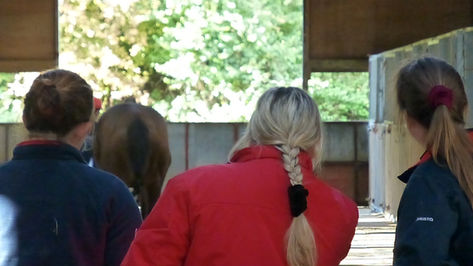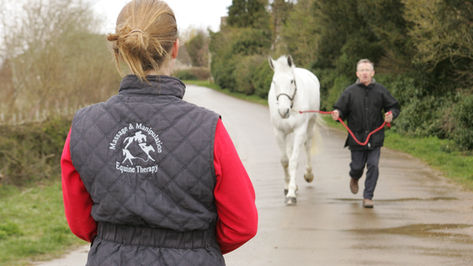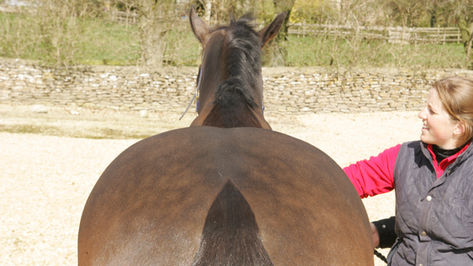Assessing Posture and Movement
2 Day Course for Horse Owners, Riders and Equestrian Professionals
with Gillian Higgins
Next Date TBA
Wavendon Grange, Lawn Lane, Old Dalby, Leicestershire, LE14 3LW
Good posture is vital for the health, comfort and performance of every horse. Posture is influenced by many things including exercise, training, musculoskeletal comfort, management, hoof balance, pain, behaviour and of course the rider!
Movement is affected by his posture, asymmetry, comfort and conformation.
As a professional, having the ability to recognise postural weaknesses and movement irregularities early on can help prevent problems from occurring. To do this accurately you need a thorough understanding of the principles of anatomy, biomechanics, conformation, and posture.

Course Trailer
This course will give you the necessary skills to systematically assess horse posture and movement. It is ideal for equine therapists, therapy students, coaches, instructors, farriers, and judges wishing to hone their skills and better understand posture, biomechanics and movement.
Through her work as a professional equine therapist assessing the posture of hundreds of horses and as an educator, Gillian has devised a clear system for assessing both equine posture and movement which she will share with you on this course.
Using a mix of theory, observation, practical demonstrations and small group sessions this course will boost your knowledge of this subject. There is also the opportunity to share information and discuss interesting or challenging cases with other practitioners in a relaxed and supportive environment.
Key Points
The course will evaluate and consider:
Postural weaknesses
Methods of assessment
Muscle development
Muscular strengths and weaknesses
Stability versus flexibility
Movement & compensation patterns
Balance, strength and stability
Asymmetry
Gait irregularities
Subtle lameness

Provisional Timetable
DAY 1
0900: Registration and Coffee
0930: Welcome and Introduction
09.45: The Importance of Posture
Classroom Session
1100: Break
1130: A System for Assessing Posture
Classroom Session
1300: Lunch
1400: Assessing Posture
Practical Session
1500: Break
1530: Assessing Dynamic Posture
Practical Session
1600: Discussion
1630: Close
DAY 2
0930: The Walk. Biomechanics, irregularities and improvement methods -Video Based Session
1030: Assessing Walk - Practical Session
1100: Break
1130: The Trot and Canter. Biomechanics, irregularities and improvement methods -Video Based Session
1215: Assessing Trot & Canter - Practical Session
1300: Lunch
1400: Bending, Backing up and Transitions
1500: Break
1520: The Ridden Horse - Practical Assessment Session
1615: Discussion
1630: Close
Notes
We envisage this course to be very popular so early booking is advised.
Certificates of Participation (CPD) will be emailed after the course. Course notes will be provided.
Tea, coffee, home-made cakes and a light lunch of sandwiches, crisps and fruit is included.
This course is held both inside and out so please bring appropriate warm clothes for a day out on the yard.
This course is limited to 14 people to ensure small groups and individual attention.
Prerequisites
All participants must provide proof of a professional equine qualification or relevant college attendance.
To get the most out of this course it is recommended you read:
and watch the on demand webinars:
Prices
Course Leader
Gillian Higgins
Gillian is an equine anatomist, biomechanist, BHS Senior Coach, professional Sports and Remedial Therapist and author with a first class honours degree in Equine Science and Business Management.
Gillian is passionate about posture. She specialises in assessing the musculoskeletal systems and designing exercise programmes for improving posture and performance as well as assessing and addressing individual horses’ weaknesses.
Gillian has studied a variety of equine and human modalities both traditional and holistic.
As well as conventional training, Gillian has studied equine therapies in America, France, Germany and Sweden and is committed to giving our equine partners the best possible levels of care and consideration.
Gillian works with horses from all disciplines and levels from leisure to Olympic.
Venue and Horses

All of Gillian's courses are supported by a wealth of photographs and video footage taken from years worth of work including footage of her anatomically painted horses and from her dissections.
Also on the day of the course, you will have access to Gillian's large collection of bones and anatomical models.
This ensures that you will be better able to visualise the structures we discuss on this course.
This course is run at the Horses Inside Out headquarters, Wavendon Grange near Melton Mowbray in Leicestershire.
The facilities at this central UK location include a small yard with a variety of horses, arenas and a classroom complete with audiovisual facilities.
This is a comfortable and professional space for learning where you are always guaranteed a friendly welcome.
Gillian has many bones, skeletons and anatomical models in the teaching barn for you to view and handle.
Being able to bring horses into the teaching barn alongside the anatomical models really helps to combine the theory and the practice!

















